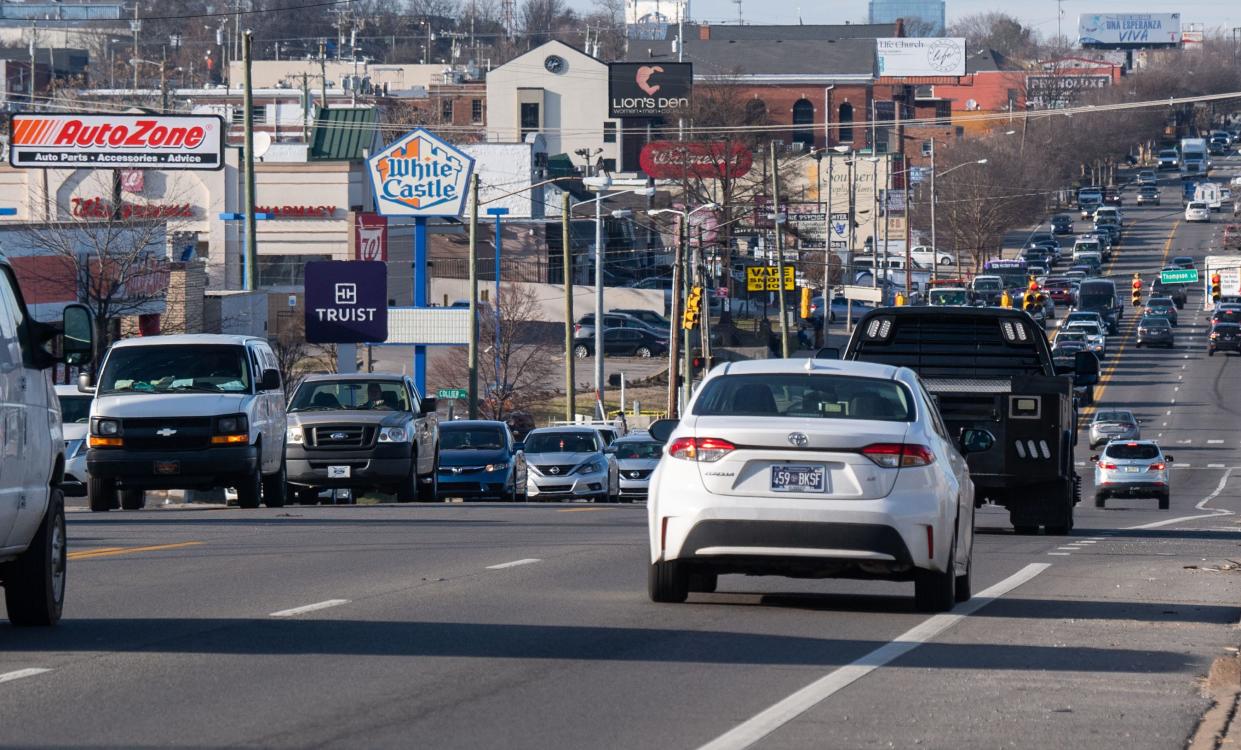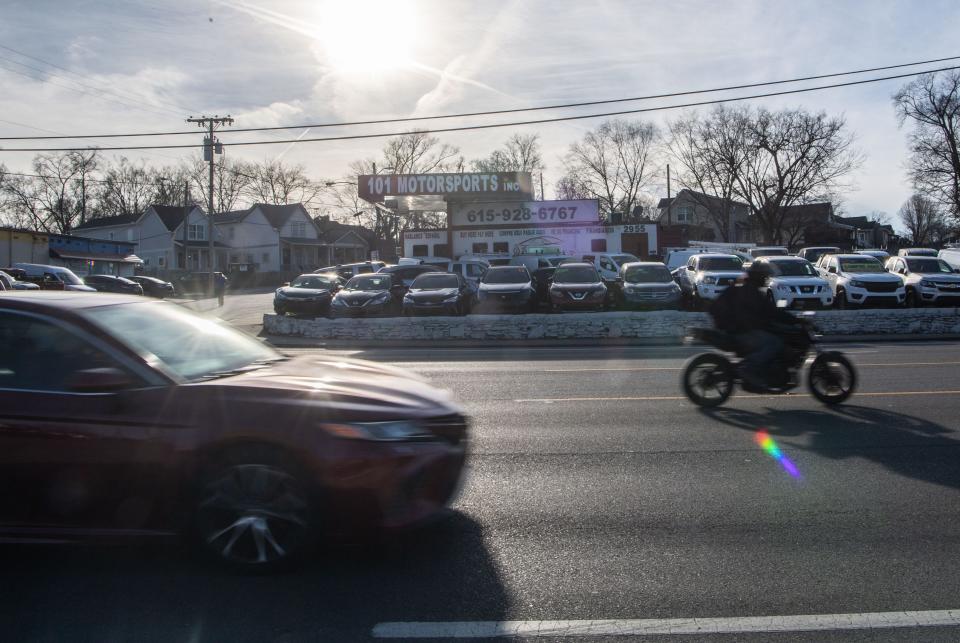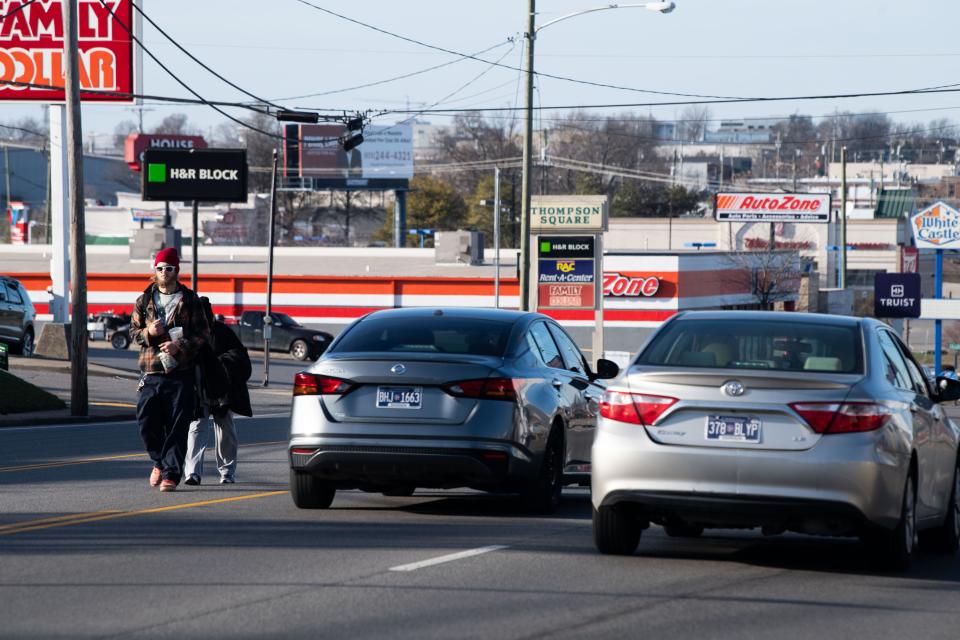Dangerous intersections plague pedestrians, cyclists in Nashville: 'We have to be aware'

Cadjos Mugabire and his father, Cyprien Munyangeyo, bonded over the popular West African dish Fufu. While living in Middle Tennessee, the two often made the dense scrumptious starchy sticky dough dish after Munyangeyo came to America as a refugee in 2016.
It's a memory Mugabire says he'll cherish, especially after his father, 62, was killed in a hit-and-run accident April 16 along Bell Road.
Munyangeyo's death is among those the Nashville and Tennessee Departments of Transportation are grappling with as Metro Nashville wrestles with making roadways and intersections safer for pedestrians, motorcyclists and cyclists.
In Nashville last year, there were 40 fatal pedestrian accidents, down from 48 in 2022. But those numbers don't tell the whole story, according to Walk Bike Nashville executive director Meredith Montgomery, who explained that while the number of fatal accidents on Nashville Department of Transportation-operated roadways fell last year, TDOT-controlled interstate and state roadways saw fatal crash numbers increase.
"We see these fatalities, and I think people get used to seeing these numbers. 'Oh, 40 pedestrians died here, 38 died here.' But these aren't numbers. Those are people. And as drivers, we have to own that power we have. And we have to be aware of our surroundings," Montgomery said.
Walk Bike Nashville will host its seventh annual pedestrian memorial Feb. 24 to honor those killed in Nashville.
"The good news is NDOT has been implementing smaller projects with leading pedestrians intervals, signals and improving some crossings. But we know that the majority of these fatalities continued to happen on our state routes, and we've got to see significant change," Montgomery said.

One death, huge impact
Munyangeyo was attempting to cross Bell Road outside a crosswalk when a white vehicle, heading west, struck him and drove away, police said. The person responsible is still at large.
“He did not deserve this tragic death,” Mugabire told The Tennessean.
The second-eldest of 10 children, Mugabire came to America from a refugee camp in Rwanda a little more than two years before his father. He attended Austin Peay State University, where he graduated in 2021 with a degree in medical laboratory sciences.
Munyangeyo worked for Sysco and Tyson, two food distribution centers, while living in Middle Tennessee.
The hard work Munyangeyo put into his jobs helped Mugabire, who said he remembers a time his father paid his rent while he was a student at Austin Peay. Munyangeyo also helped organize Mugabire's wedding in 2019, his son said, and in 2021, father and son celebrated Mugabire's college graduation together in a moment that Mugabire said he will never forget.
Mugabire is still hoping to find answers in his father's death as police continue their investigation. He's not alone. Many other families are seeking similar answers in Nashville, and many are wondering what can be done to help put a stop to the deadly crashes.
It all starts with the city's roads.
More: 10 worst: Nashville's most dangerous streets for walkers
Last year, Murfreesboro Pike was the deadliest Nashville road with five fatal pedestrian accidents reported by the Metro Nashville Police Department. The thoroughfare is on everyone's mind at Walk Bike Nashville, Montgomery said.

Motorcyclists are also top of mind.
Though the number of pedestrian accidents decreased slightly from 2022 to 2023, those involving motorcycles increased from five in 2022 to 19 in 2023, the Metro Nashville Police Department reported.
As Nashville's footprint expands, residents are seeking alternative forms of transportation to beat interstate traffic. And Montgomery said Walk Bike Nashville believes its job is to inform the community of the issues, tracking data and knowing where hot spots are in Metro Nashville.
Even more than deaths, Montgomery said, there are countless near misses involving injuries on Metro roadways.
Part of the fixes in Metro Nashville are quick build projects that include painting safety areas and lane width reductions, putting up more signage and lighting. Anything requiring concrete or a sidewalk is considered a long-term build.
Still, Montgomery said the quick builds are more of a bandage on the bigger problems for people trying to get around the city.
"We need sidewalks everywhere, and it's going to take decades to get us there on the pace that we're at," she said.
TDOT multimodal planning manager Daniel McDonell said a study that began in 2020 revealed several locations in Metro Nashville with many receiving attention in the coming years to curb accidents and fatalities.
The most dangerous stretches for pedestrians last year
Eighth Avenue from Broadway to West End Avenue from 23rd Avenue North to Eighth Avenue South reported 20 pedestrian accidents, including non-fatalities.
Lafayette Street and Murfreesboro Pike from Division Street to Menzler Road had 16 accidents.
Murfreesboro Pike from Menzler Road to Vultee Boulevard had 16.
Gallatin Pike from Walton Lane to Wiley Street reported 12.
Dickerson Pike from Trinity Lane to Ewing Broadmoor Streets reported 10.
21st Avenue South from south of Medical Center Drive to 19th Avenue South had eight.
Nolensville Pike from Haywood Lane to McNally Drive reported seven.
Trinity Lane from Brick Church Pike to Dickerson Pike reported seven.
Charlotte Avenue from east of 23rd Avenue to 19th Avenue North reported four.
Harding Place from Linbar Drive to near Harding Industrial Drive reported four.
Over a four-year study, the most dangerous intersection was Eighth Avenue at Lafayette Street, with 58 pedestrian accidents.
Biking Music City
While Metro Nashville's walkability is lagging, its burgeoning bicycling scene leaves a lot to be desired. Many are turning to bicycling as a different form of transportation with projects sprouting up to close the gap on safety concerns after Nashville was named the fourth-worst city for biking.
Hope Gardens resident Chris Ashton said safety depends on where you ride in Nashville. He's been riding around the city since 2011 and has used biking as his primary form of exercise since 2018.
"I can generally get around the city core, but I have a pretty good handle on side roads, shortcuts, sidewalks and other things to stay away from traffic," Ashton said.
One place he said he avoids is Charlotte Avenue. Ashton refuses to ride there, despite bike lanes.
"And some places are OK at 6 a.m. but too dangerous once rush hour hits," he said. "I think the city's doing good things, but ideas about cars and driving are deeply ingrained in the population and hard to change."
He said many of the city's roads are dangerous by design with troubling blind spots for drivers.
To deter vehicle versus bicycle crashes, white tube dividers have been placed between bike lanes and vehicle lanes in some areas
Ashton finds those problematic.
"As cars go faster, I just feel less safe. Even with the dividers, cars from behind whooshing past me is not a pleasant feeling," he said.
And Ashton said many of the dividers get filled with trash, rubble and debris that forces him and other riders to slalom around them like skiers. And when riders get to intersections, the dividers disappear.
"Consider the situation where at an intersection, I want to go straight and the car next to me wants to turn right. Who has the right of way, and do they know I'm next to them?" Ashton said.
Vision Zero comes into focus
In August 2022, the Vision Zero Action Plan was adopted in Nashville with a commitment to prioritize safety in Music City.
As part of Mayor Freddie O'Connell's $514 million capital spending plan, released last month, Vision Zero is expected to receive $12.5 million. Other financial allotments include $10 million for sidewalks and $5 million for bikeways.
The plan has been tasked to identify areas in Metro Nashville that can be made safer. Implementation of that plan is taking place, with projects sprouting up on several impacted roads and intersections.
In its first fiscal year, Vision Zero earmarked $25 million in funding for various projects that include curb extensions, truck aprons, pedestrian signals, protected left turn movements and mini medians and pedestrian refugee islands.
Among those projects are various roads intersecting Gallatin Pike. Other ongoing projects include Dickerson Pike sidewalk construction improvements and pedestrian crossings at Nolensville Pike, Old Hickory Boulevard and Pettus Road.
But time is against those looking for quick safety fixes, Montgomery said, noting the Dickerson Pike project could take three to five years to complete.
"The good news is that we know things will happen. It's just they can't happen fast enough," she said.
Vision Zero coordinator Guneet Saini said NDOT's goal is to provide more projects, though some project managers are handling 20 projects at one time.
Even quick build projects take time, Saini said. Some builds designed in April 2023 remain in the design stage.
"It takes time, you know, for every project to move from milestone one to milestone two," Saini said.
And sometimes, a simple fix like adding more crosswalks is shortsighted within design phases. Saini said engineers need to design crosswalks that can be used by everyone, including those with disabilities.
How Nashville compares to other Metro cities
Many cities have Vision Zero plans or walk/bike advocates seeking to improve safety in metropolitan areas. Compared to Nashville, other cities of similar size reported:
Kansas City: 24 fatal accidents involving pedestrians and bicyclists last year.
Indianapolis: 47 fatal pedestrian accidents last year.
San Jose: 47 fatal pedestrian accidents last year.
Cleveland: 56 fatal pedestrian accidents last year.
A disturbing trend
While much of the safety concerns remained focused on pedestrians and cyclists, Nashville's growing number of motorcycle fatalities received little explanation from NDOT.
"There has been an increase in the motorcycle usage in the past few years," Saini said. "There are a lot risk factors, like the roads, they have a similar vulnerability (as pedestrians), and even more so, because they are in the middle of the road."
Saini said a lack of blind spot views on motorcycles and speeds of either motorcycles or vehicles involved in crashes contributed to the rise.
While long-term solutions to the crisis may take decades to finish, Montgomery said community involvement and conversations with state and local leaders will lead to change.
"We've got to stop blaming pedestrians. It's the cars that are killing people. ... Whether you're in a crosswalk or not, you are the vulnerable user, and when you are driving, you are the one that has the killing machine, the potential to end somebody's life, and so we've got to think in that mentality," she said.
This article originally appeared on Nashville Tennessean: Nashville plagued by pedestrian deaths, dangerous intersections

